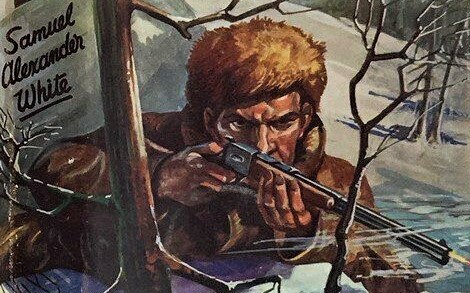When Canada Had Its Own Culture: Wild Animals & Mounties

Our Two Great Canadian Literary Genres
“The animals are us.” – Margaret Atwood
When Charles G D Roberts created the Realistic Animal Story in the 1890’s, he gave the world the first Canadian Literary Genre. When the Reverend Charles William Gordon followed with his Corporal Cameron novels, he perfected the second great Canadian Literary Genre: Mountie Fiction.
American Jack London, inspired by Roberts’ wild animals and his own lean, hard year in the Canadian Klondike Gold Rush, gave us THE CALL OF THE WILD in 1903. Creating the Northwestern (or “Northern”) genre which combined the two.
And hundreds of talented writers followed over the next four decades.
Born in an Ontario pioneer village in 1885, Samuel Alexander White spent most of his writing years telling of the wild Northcountry and its surrounding seas.
 Samuel published his first novel, STAMPEDER, in 1910 and his last, FLAMING FURLANDS, 38 years later. He also wrote Northwestern short stories during those years, many of his best falling into the Animal Stories category.
Samuel published his first novel, STAMPEDER, in 1910 and his last, FLAMING FURLANDS, 38 years later. He also wrote Northwestern short stories during those years, many of his best falling into the Animal Stories category.
Editors were soon calling him “the Jack London of Canada.” While a few detractors referred to his full-length novels as “disorganized, badly written and inconsistent.” His best work certainly was his short stories.
His books, like those of James Oliver Curwood and William Byron Mowery, not only gave readers wonderfilled descriptions of the beautiful and savage country itself, but told romantic stories, gaining him a loyal readership from both men and women.
Samuel was also an instinctive artist and sometimes illustrated his own books. Those images had flowing lines and texture that seemed to come out of the very fabric of our True North.
Samuel Alexander White’s Mountie Fiction 1938 to 1945
Although he had written yarns about Canadian Mounted Police for years, Samuel decided to concentrate almost completely on full-length Mountie novels in 1938 with the release of NIGHTHAWK OF THE NORTHWEST.
The late Thirties saw the peak of Mountie fiction in books, magazines and Hollywood productions and Samuel Alexander White’s first books sold well.
 But the Second World War saw a sudden dramatic change in popular culture.
But the Second World War saw a sudden dramatic change in popular culture.
While the American Western, Detective and War stories became darker, more violent and even erotic, Mountie Fiction seemed suddenly “out of touch.”
OUT OF TOUCH:
…The hauntingly beautiful but distant Canadian Northcountry.
…The themes of Stoic-Christian resolve, charity and service that Charles Gordon had introduced to Canadian literature.
…The Nineteenth Century masculine Code of Honour, Chivalry and Self-sacrifice.
All being replaced by the mean city streets, Modern Materialism and shameless self-interest.
The Mountie as cultural icon was suddenly obsolete.
Phoenix Press of New York, aware that White was retaining his loyal following, still published his works.
But while Samuel’s British publisher continued to use his red-coated Mounted Policemen on their book covers, Pheonix covers were deliberately “Americanized” — no more Canadian imagery, their artists painted scenes with Western characters who looked like cowboys of the Southwest.
Today, of course, Canadian culture (except for our Hockey!) has been forgotten.
And replaced and remade in the same way Samuel’s book covers were.
But, thank God, those great and truly Canadian Voices, those intoxicating sacred stories that grew out of the very soil we walk on, are still out there to be rediscovered and read.
See more at my CALL OF THE NORTHWESTERN GENRE: Best Books, Animal Stories & Mountie Fiction.
And my controversial Post CANUCK MOVIES: Mounties, Nell Shipman & the Canadian Spirit — A Patriot’s Rant.
 Learn more about the essential place our Mounties once had in Canadian Culture, See “GREATEST WRITERS OF NORTH-WEST MOUNTED POLICE FICTION”
Learn more about the essential place our Mounties once had in Canadian Culture, See “GREATEST WRITERS OF NORTH-WEST MOUNTED POLICE FICTION”
Thus endeth my Rant of the Day…
When Canada Had Its Own Culture: Wild Animals & Mounties
 Learn more about the essential place our Mounties once had in Canadian Culture, See
Learn more about the essential place our Mounties once had in Canadian Culture, See